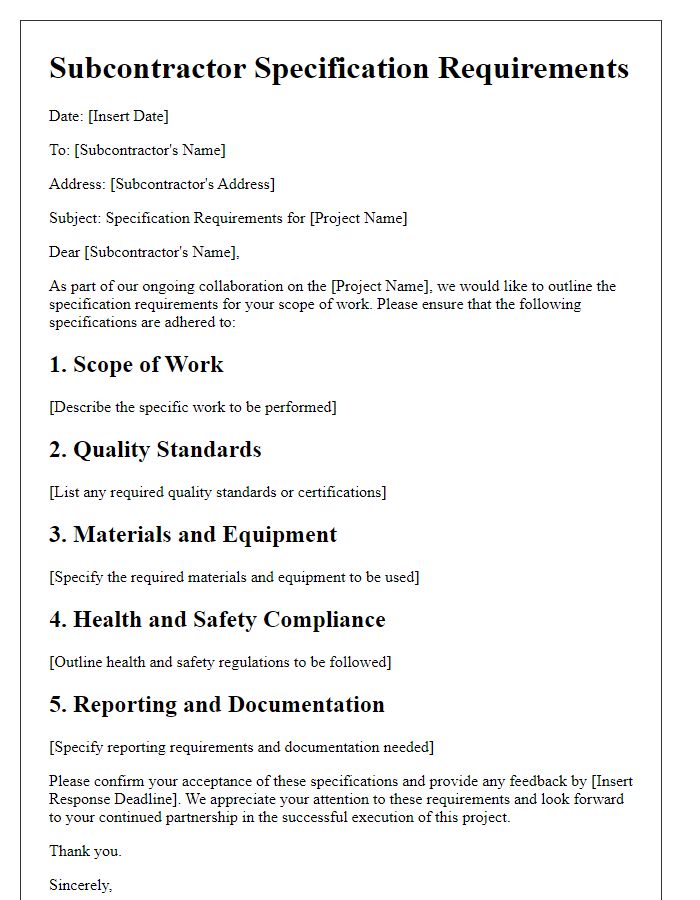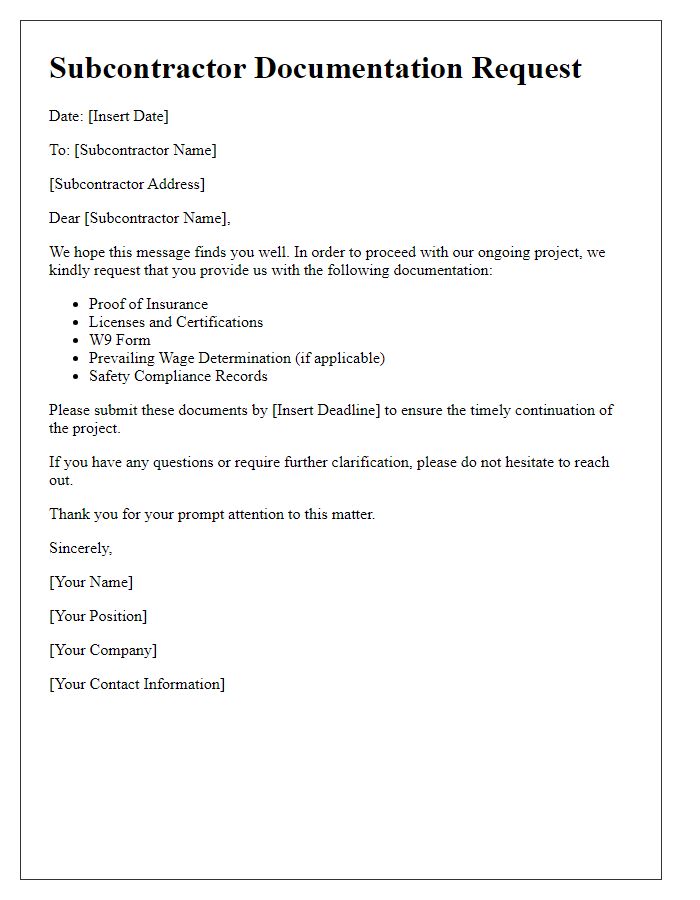When it comes to collaborating with subcontractors, having a clear set of technical specifications is crucial for ensuring everyone is on the same page. A well-crafted letter can set the tone for productive communication and establish the standards required for a successful partnership. This request not only outlines your expectations but also serves to clarify any specific guidelines that need to be followed. Ready to enhance your subcontractor relationships? Let's dive deeper into how to write an effective technical specification request!

Project Details
In project management, requesting technical specifications from a subcontractor involves detailed documentation of project details. The project title, such as "Greenfield Housing Development," outlines the nature of the endeavor. The project location plays a vital role, with "1234 Maple Street, Springfield, IL" providing clarity on site conditions and logistical considerations. The project timeline specifies crucial milestones, such as "Phase 1 Completion" by March 2024, setting clear expectations. Additionally, the budget, indicated as "$1.5 million", guides the scope of materials and services. Required specifications include compliance with local building codes, sustainability criteria, and safety regulations, ensuring all subcontractors align with overall project standards. Moreover, the request emphasizes detailed submissions, such as material samples, product data sheets, and updated schedules, critical for informed decision-making.
Technical Requirements
Subcontractors must adhere to strict technical specifications when working on projects like infrastructure development or residential construction. Compliance with industry standards, such as ASTM (American Society for Testing and Materials) or ISO (International Organization for Standardization), ensures quality and safety. Specific details required include materials to be used (for example, concrete grade like C30/37), dimensions based on architectural plans, and performance criteria for systems such as HVAC (Heating, Ventilation, and Air Conditioning). Timelines for material delivery, such as concrete curing times (typically 28 days), and testing protocols must also be specified to guarantee alignment with the project schedule. Furthermore, documentation such as shop drawings and product data sheets should be submitted for approval to mitigate risks and ensure regulatory compliance.
Submission Deadline
Submission deadlines play a critical role in project management, particularly in the construction and engineering sectors, ensuring timely delivery of technical specifications from subcontractors. For example, a typical submission deadline might be set for 15 days prior to the scheduled start date of a construction phase, allowing project managers to review critical documents such as engineering drawings, compliance reports, and material data sheets thoroughly. This timeframe enables necessary adjustments and clarifications to be addressed ahead of time, minimizing project delays and ensuring adherence to industry standards. Specifying a precise date, such as October 31, 2023, establishes clear expectations and accountability among subcontractors, facilitating effective communication and collaboration throughout the project lifecycle.
Quality Standards
Quality standards serve as critical benchmarks for subcontractor performance across various construction, manufacturing, and service industries. ISO 9001, an internationally recognized quality management standard, emphasizes customer satisfaction and continuous improvement, requiring subcontractors to implement systematic processes. Specific materials, such as ASTM steel and EN certified components, are often mandated to ensure durability and compliance with safety regulations. Detailed inspection protocols must be established, with visual inspections, non-destructive testing (NDT), and compliance documentation serving as essential practices. Additionally, maintaining safety standards established by OSHA (Occupational Safety and Health Administration) protects workers on-site and minimizes liability risks. Subcontractors must document their adherence to these quality standards to facilitate audits and inspections, ensuring transparency and accountability in project execution.
Contact Information
Subcontractors seeking to provide technical specifications must submit accurate and detailed contact information to facilitate effective communication. Essential details include company name, which identifies the subcontractor in the industry, primary contact person's name, ensuring accountability, email address, which should be active for prompt responses, and phone number for direct communication. Additionally, including a physical address enables logistical arrangements and on-site meetings. This information is crucial for collaboration on projects, such as construction in New York City, where multiple stakeholders are involved. Accurate contact information ensures timely updates and clarifications throughout project execution.













Comments